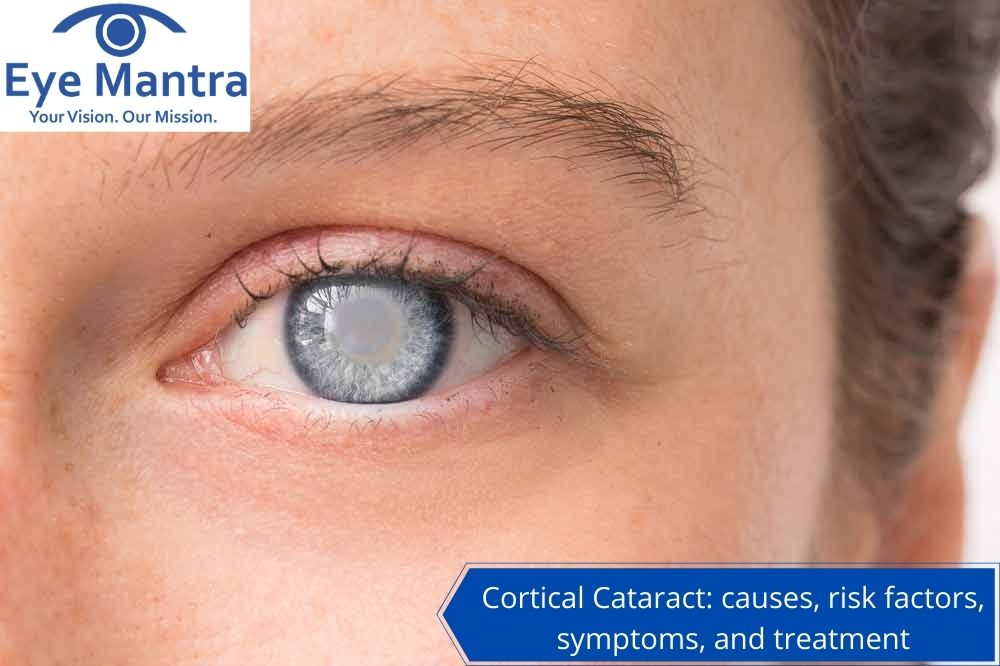Contents
Cortical Cataract: Causes, Risk Factors, Symptoms, and Treatment
A cortical cataract is a condition in which the healthy and naturally crystalline eye lens becomes cloudy, opaque, and blurred. As a result, it fails to form a proper image of the object. This is a part of the aging process and affects the vision of the person to a great extent. This is probably the most common cause of vision loss in people of more than 40 years of age.
There are different types of cataract including:
- Subcapsular cataract
- Nuclear cataract
- Cortical cataract
Different types of cataracts occur in different parts of the eye lens. A cortical cataract is the one that begins on the outside edge of the lens (the periphery), characterized by white streaks and wedge-shaped opacities which are commonly called cortical spokes. These spokes start from the edges of the lens and make their way to the center, hence blocking and impairing vision (although the vision impairment is dependent on the location where the opacities are present). This type of cataract generally occurs in the lens cortex, which is the part of the lens that surrounds the central nucleus.
Cortical cataracts typically occur in both eyes (bilateral) but can occur in only one eye (asymmetric) as well. Cortical cataracts are generally found to cause issues with glares around lights and increased light sensitivity. These cataracts can progress both slowly and rapidly depending on the seriousness of the condition of the patient. They even can stay in the same condition for a very long time.

Causes Of Cortical Cataract
The natural lens of the eye is made up of water and special proteins. In a healthy eye, these proteins are naturally arranged in such a way that the light rays coming from the object do not get interrupted and thus clear images can be formed and easily get passed through these proteins. Unfortunately, with age, some of these proteins begin to clump together. As a result, the images that pass through them begin to appear cloudy or hazy. This is the reason why cataracts are a part of the aging process and become more prominent as the person crosses the age of 40.
Like the other type of cataracts, cortical cataracts can also be the result of some natural processes like aging, trauma, or some sort of old illness. Cortical cataracts majorly start to develop when the structure of the fiber cells gets disrupted, and the integrity of the membrane is compromised.
Risk Factors of Cortical Cataract
People with an increased intake of carotenoids in their diet are found to be at a lower risk of cataracts. In comparison with normal people, the ones with the following disorders or problems are found to be at a higher risk of cortical cataracts:
- Diabetes
- Hypertension
- Cigarette smoking
- Tobacco smoking
- Previous eye injury or eye surgery
- Prolonged use of corticosteroid medications
Symptoms of Cortical Cataract
Some of the common symptoms shown by people with cortical cataract include:
- Blurred and dim vision: The most important symptom of a cataract is blurred vision. Due to the opacification of the eye lens, people with cataracts fail to see a clear image of the objects. Hence, the images they see are either blurred or hazy. Moreover, the vision of the person gradually reduces to a minimum due to the inability of the eye lens to form proper images of the objects.
- Increased sensitivity to light and glare: People with cataracts (cortical cataracts in particular) usually find the light coming from a highly illuminated source such as a lamp or the headlights of the approaching vehicle too bright and glaring. Light coming from any source suddenly starts causing more glare than before to the eyes of a cataract patient.
- Fading of Colors: While the cataract eyes face increased sensitivity to light and glare, they tend to lose their bright identification of colors as well. Colors no longer seem as bright as before to the people with cataracts.
- Other Minor Symptoms: Apart from the major symptoms mentioned above, certain minor symptoms of cortical cataract as seen in people, include double vision, night blindness (in some cases), difficulty in reading in dim lights, etc.
If a person experiences any one or more of the above symptoms regularly, he/she should immediately consult an eye specialist. People above 40 years of age should consider these symptoms as obvious signs of cataract whereas people younger than this should ask the doctor to properly diagnose for any other eye problem as cataract has slightly fewer chances of hitting at a younger age.
Treatment For Cortical Cataract
If a cataract is left untreated or improperly treated will continue to grow and cause further major problems in the vision of the patient. Hence, opting for a suitable treatment option is recommended, before the condition gets worse. Generally, cataracts are treated either through the use of prescription glasses or operating through cataract surgery.
Prescription eyeglasses (or bifocals) are considered the first step to help a cataract patient improve his/her degraded vision. If the patient already wears glasses, the doctors might provide him prescription glasses updated to greater power in an attempt to help the patient see more clearly.
However, this treatment option is just a short-term solution to cortical cataracts.
Cataract surgery performed by a skilled eye surgeon is the next and the ultimate step when prescription glasses fail to treat the cataract in the eye. Cataract surgery is nothing but a replacement process. The cloudy lens of the eye is replaced with an artificial lens in its place.

Types of Surgeries For Cortical Cataract
Phacoemulsification
The surgeon carrying out the surgery uses a handheld instrument and releases an ultrasonic pulse. The sent signal is so strong that it destroys the cataract present in the eyes into bits. A tube, acting as a vacuum pump sucks the destroyed material out of the eyes of the patient. Finally, the patient’s eye lens gets replaced by an intraocular lens.
Femto Cataract Surgery
Femto cataract surgery is nothing but an improved and advanced version of the phacoemulsification process. This type of surgery uses a femtosecond laser to make a small opening in the eye and the lens anterior capsule. It then fragments the lens present in the eye into pieces and places toric cuts on the cornea in case there is high cylindrical power in the eye. The outcome of this type of surgery is safer and more predictable than the previous one.
Cataract surgery has become common, as a huge number of cataract patients undergo this surgery each day. Out of those who opt for the surgery, nine out of ten reports that their vision gets restored between 20/20 and 20/40 after the surgery.
Preventive Measures To Avoid Cataracts
Quit smoking: Do not smoke. If you do, try quitting it as soon as you can. Try asking your doctor for advice regarding how to stop smoking. This might include medication, counselling, and other such strategies.
Take a healthy diet: Increase the intake of vitamin A in your diet to keep your eyes healthy. Studies have shown that an adequate number of antioxidants in one’s diet can also help to prevent cataracts. Avoid taking food items that pose risk to the development of cataracts.
Wear sunglasses: Minimize direct exposure of sunlight to your eyes as it is not good for your eye health. Apart from cataracts, it can cause various other eye problems as well.
[video_lightbox_youtube video_id=”eTkZm4vjHBg” width=”1200″ height=”800″ auto_thumb=”1″]



